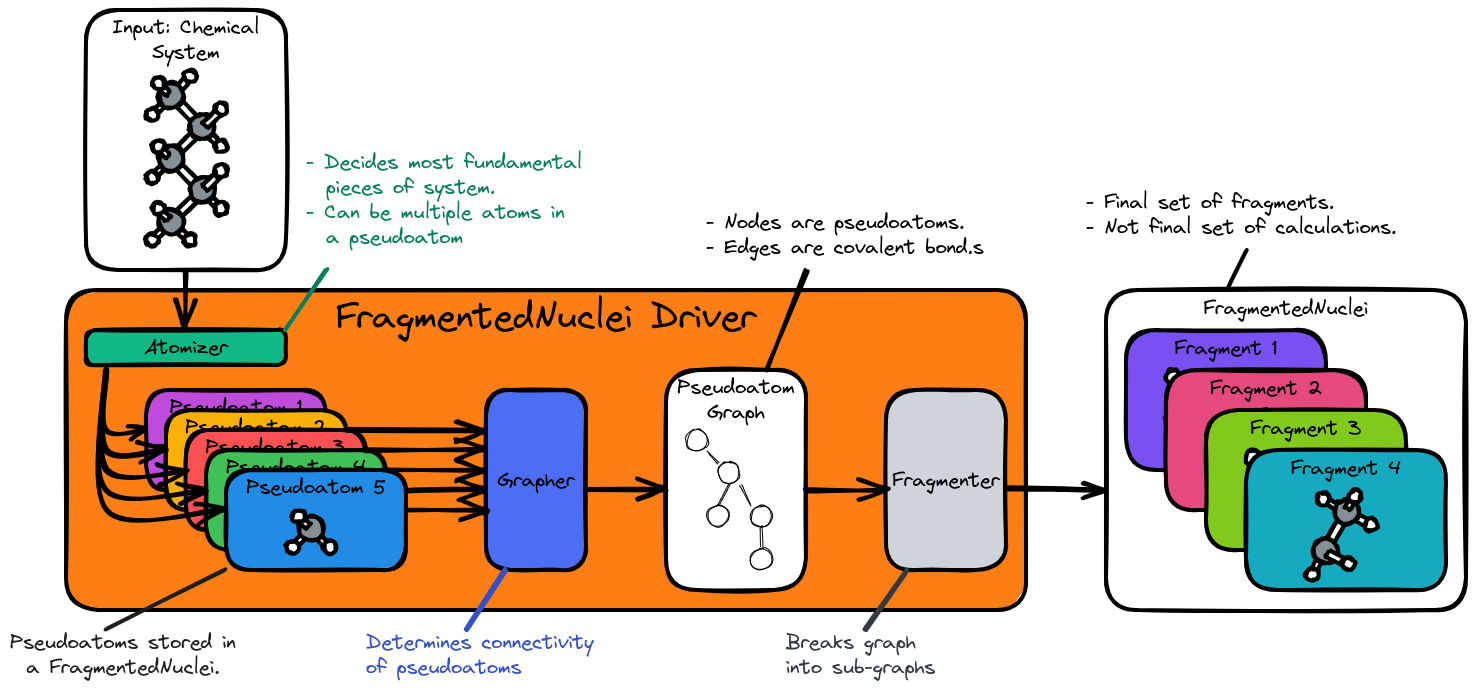Designing GhostFragment’s FragmentedNuclei Driver
What is the FragmentedNuclei Driver?
The FragmentedNuclei driver is responsible for dividing the nuclei of a
molecular system into fragments. The resulting fragments will then be further
processed by the FragmentedMolecule driver.
FragmentedNuclei Driver Considerations
- Hierarchy base
The
FragmentedNucleidriver is assumed to be the base driver of theFragmentedNuclei,FragmentedMolecule, andFragmentedSystemhierarchy.
- Pseudoatoms
As the base of the hierarchy, the
FragmentedNucleidriver’s first task is to determine the set of pseudoatom(s) s which will be used to form fragments.
- Connectivity
The majority of fragmentation algorithms need not just a set of pseudoatoms, but also the connectivity of those pseudoatoms.
- Generality
The
FragmentedNucleidriver is envisioned as being the piece which needs to vary the most among existing fragment methods. Many existing fragment- based methods differ only in how the initial fragments are formed.
- Chemical system input
While it may seem logical to take a
Nucleiobject as the input, by taking aChemicalSystemwe open up the possibility for theFragmentedNucleidriver to use additional information to choose theNucleisets. For example, using the charge could be helpful for assigning connectivity, and for prescreening fragments based on energetic contributions.Put another way, the
FragmentedNucleichosen by the driver need to be representative of the system being fragmented. This requires the driver to have knowledge of the entire system, not just the nuclei.Since a
ChemicalSystemcontains aNucleiobject, drivers which do not need additional information are free to ignore the extra state.
- n-mers
From the perspective of the rest of GhostFragment, there is no difference between an n-mer and a fragment. In order to encapsultate the detail of whether GhostFragment is dealing with n-mers vs. fragments we want the
FragmentedNucleidriver to have the same API as the n-mer driver.
FragmentedNuclei Driver Design

Fig. 7 The architecture of the FragmentedNuclei Driver.
Fig. 7 shows the main pieces of the
FragmentedNuclei driver. Following from consideration Pseudoatoms,
the first step is the creation of “pseudoatoms” by the Atomizer component.
As suggested by Fig. 7, the Atomizer
actually satisfies the same property type as the driver, which in turn allows
the pseudoatoms to be used as bona fide fragments. Regardless of exactly how
the pseudoatoms are chosen, the Atomizer ultimately defines the smallest
units for the fragmentation algorithm.
With the pseduoatoms established, the next consideration is
Connectivity, i.e., determining which pseudoatoms are bonded to
eachother. The pseudoatoms plus the connectivity establishes a molecular graph.
It is this moleculer graph which is ultimately decomposed by the Fragmenter
module. The Fragmenter module is responsible for addressing the
Generality consideration; in particular it is the Fragmenter
module which will usually be substituted out to change how fragments are formed.